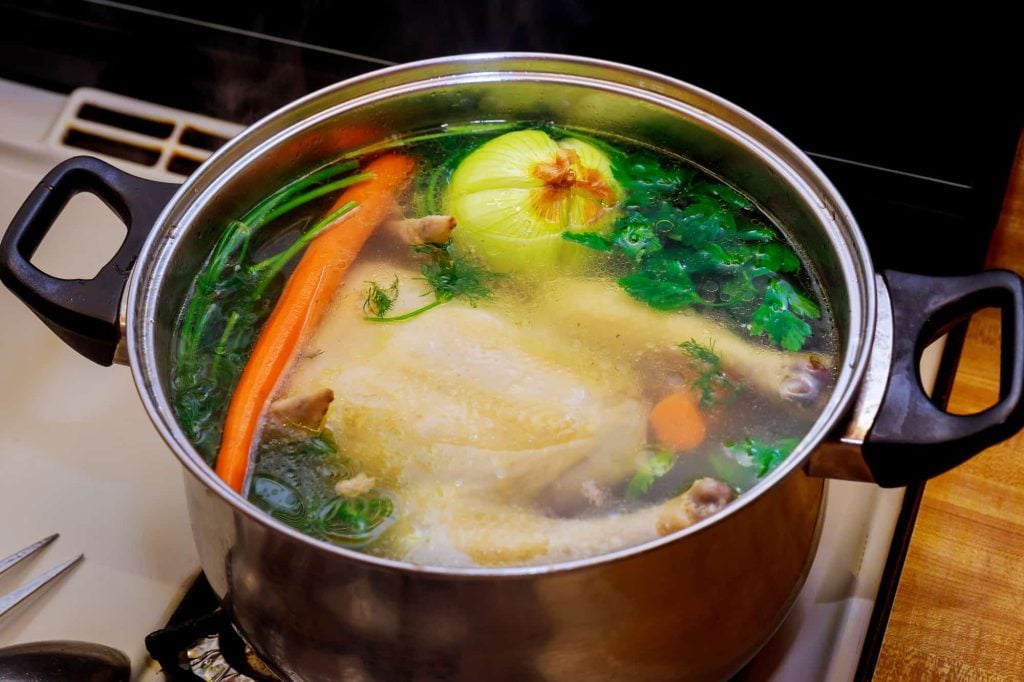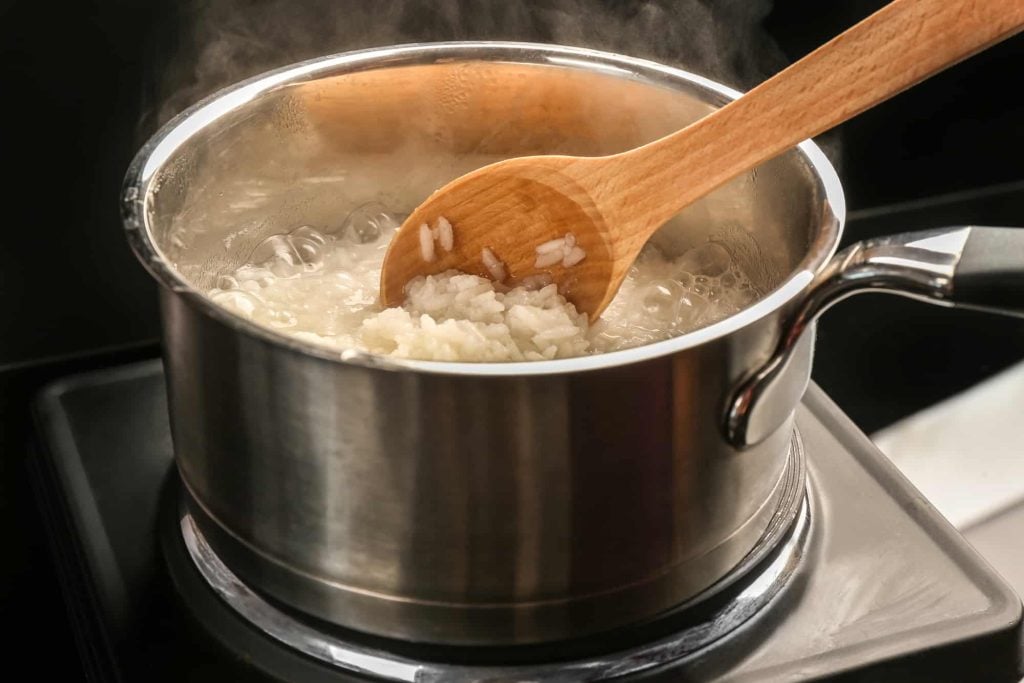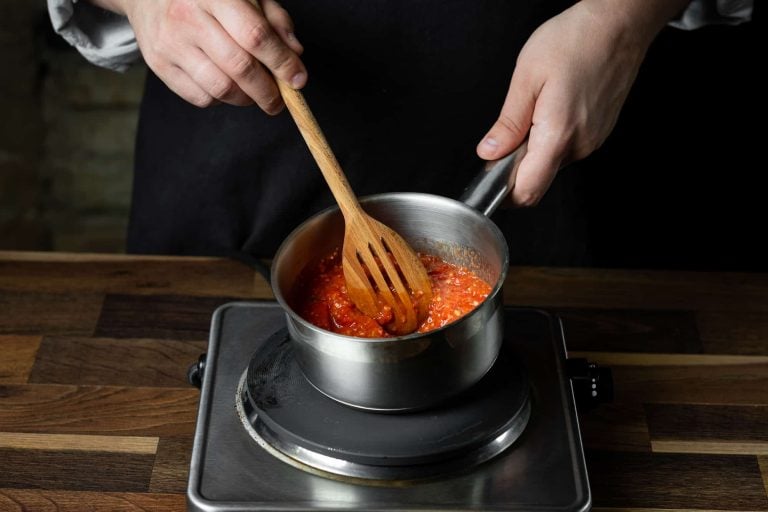Simmering food is a beautiful cooking method that helps you create hearty dishes and bold flavors. Mastering the technique is an invaluable skill as you can use it for cooking a wide variety of foods.
When you simmer food, you are moist-cooking and cooking at a medium temperature, somewhere between poaching and boiling (source: Masterclass).
Whether you simmer your food with the lid on or off depends on what you are cooking and what you intend to achieve. Keep the lid on if you want to meld the flavors of the ingredients without reducing it. If your dish is too thin and you want to reduce the water content, take the lid off.
Let’s look at how to simmer popular dishes in more detail ( source: Table Matters).
Simmering Chili – Lid Off or On
The perfect chili is warm, spicy, and full of flavor. It is the coming together of all the spices and additional ingredients that form this hearty dish. Chili is typically made with tough ground meat which is tough. The simmering process softens the meat while also allowing the spices to blend.
To create the perfect chili:
- Add your ingredient to the cooking pot and bring to a boil with the lid on. Keeping the lid on the pot helps retain heat, and the food comes to a boil quicker.
- Once your chili has come to a boil, remove the lid.
- Simmer the chili for about thirty-five to forty-five minutes with the lid off on high.
If you’ve added a lot of liquid or the consistency is too runny for your liking, keeping the lid off will allow the excess liquid to evaporate. At the same time, the spices meld together, leaving you with a thicker consistency and bold flavor.
If you’re looking for a more enhanced flavor and have a bit of time, you can simmer the chili on low heat for up to two hours. Since the heat is low, keep the lid on to maintain the heat level. The longer you leave the chili to simmer, the more flavorful it will become as you’re giving it more time for the flavors to develop and blend.

Simmering Soup – Lid on or Off
Soup is a favorite for many. It’s also pretty easy to make. Traditionally, most people prefer simmering soup because this method allows enough time for flavors to get extracted from your ingredients and infused into the soup. This results in a delicious soup.
To simmer soup:
- Prepare your soup ingredients, such as vegetables or pieces of meat, and add your preferred flavoring.
- Place your soup pot on your stovetop, add water or stock and turn on the heat source.
- Bring the pot to a boil and then lower the heat.
- Simmer the soup until you attain the level of thickness you desire.
Cooking your soup uncovered will allow water to evaporate, so do this if you wish to make a thick soup. Another benefit of cooking your soup without the lid is that the depth of flavors gets more concentrated (source: Show).
Simmering Stock (Always Lid Off)
A flavorful stock is the base of many dishes and must be made correctly. Simmering is the primary cooking process for making stock.
Stock is essentially water that’s been flavored with bones, meat, vegetables, and some aromatic spices. To extract the most delicious flavor out of these ingredients, the water needs to simmer for a long period of time, at least three to four hours, but longer is better.
When making stock, always allow it to simmer uncovered on a medium-low heat setting. The lid must be kept off the pot to allow water to evaporate so that you get a more concentrated flavor. Another reason to simmer the stock uncovered is for temperature control and to prevent it from boiling (source: BBCGoodFood).
You will know your stock is simmering at the right temperature when tiny bubbles form but don’t break the surface.
Do You Simmer Chutney With the Lid On?
A good chutney should be thick and slightly acidic. To get the right flavor and ideal consistency, cook your chutney in a pot with a broad base. Additionally, let it simmer on medium heat without a lid on for about two hours. Keeping the lid off allows the liquid to evaporate, making the chutney thick and intensifying the deeper flavors.
If you put the lid on the pot, you risk your chutney becoming runny and thin as there is little room for the excess water to evaporate.
Keeping the lid off also makes it easier for you to stir the mixture every few minutes so that it doesn’t stick to the bottom of the pot and burn. It also ensures that the chutney doesn’t boil, as boiling it will alter the taste and rich texture.

Simmering Sauce (Usually, Lid on)
Sauces should not be too thick and should have a runny consistency. Simmer the sauce with the lid on. This stops too much water from evaporating, ensuring most of the moisture stays in the sauce.
Set the cooking temperature to low and leave the sauce to simmer for as long as possible as the low heat and long simmer time allow the flavors to develop.
Even though the pot is covered, you must remember to stir the sauce to prevent it from sticking. Also, keep checking to make sure that there is enough liquid because even with the lid on, a little water will evaporate. And if it becomes too thick, it will become more like a paste than a sauce. Top with water or stock if necessary.
Another reason to keep the lid on your sauce is to prevent it from spluttering. This can be dreadful to clean up. Besides, you end up with half the sauce on the walls, stovetop, and counters rather than in the pot. The lid ensures the sauce is contained inside the pot.

Rice (Simmer with Lid Off, Then On)
The tastiest rice is light and fluffy, and it gets to be this way by absorbing water. To get your rice to the perfect consistency, add water and bring it to a boil uncovered. After it’s come to a boil, turn the heat down to medium, cover with a lid and let it simmer until cooked.
It would be best to put a lid on the rice to prevent the water from evaporating. Rice needs to absorb water to get a fluffy texture. If the water evaporates instead of being absorbed by the rice, you will be left with chewy or hard rice. Stir the rice occasionally and top with more water when needed.
To flavor your rice, you can substitute water for stock. Squeeze a grain between your index finger and thumb to test when your rice is cooked. It should feel soft and tender.
Overall, consider what you are trying to achieve when a recipe calls for simmering food but does not indicate whether you should take the lid off or keep it on.
To thicken a sauce or reduce the water content, simmer with the lid off but cover the pot if your goal is to keep/absorb the water content while developing the flavors.





Comments are closed.